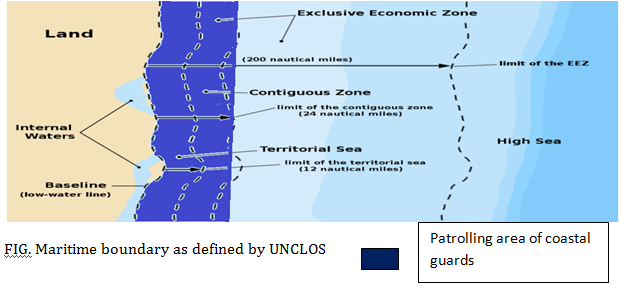

- ICGS Varaha, the fourth in the series of 98 M offshore patrol vessels (OPVs) of Indian Coast Guard, was launched.
- It is fourth in the series of 98 M OPVs (Offshore Patrol Vessels) developed by Larsen and Turbo (L&T).0
Context
- ICGS Varaha, the fourth in the series of 98 M offshore patrol vessels (OPVs) of Indian Coast Guard, was launched.
- It is fourth in the series of 98 M OPVs (Offshore Patrol Vessels) developed by Larsen and Turbo (L&T).0
About
- Off shore patrol vehicles (OPVs): They are patrolling vehicles which are deployed by Indian coast guards to patrol maritime boundary of India.
- Coast guard vessel Vikram was the first in the class of seven new-generation offshore patrol, out of which four have been commissioned including Varha.
- All OPVs have been made indigenously under “Make In India” initiative.
ICGS Varsha
- It is equipped with advanced technology navigation system and communication equipment with sensor.. Its armoury includes one 30 mm and two 12.7 mm guns with fire control system.
- It can attain maximum speed of 26 knots and has endurance of 5,000 nautical miles.
- It also equipped with an Integrated Bridge System (IBS), Automated Power Management System (APMS), Integrated Platform Management System (IPMS), and High Power External Fire Fighting (EFF) system.

Maritime boundary:
- Maritime boundary of a country is defined by United Nations Convention on Laws of Seas (UNCLOS)
- UNCLOS: Also known as the Law of the Sea Convention or the Law of the Sea treaty, is the international agreement that resulted from the third United Nations Conference on the Law of the Sea (UNCLOS III)
- It defines the rights and responsibilities of nations with respect to their use of the world's oceans, establishing guidelines for businesses, the environment, and the management of marine natural resources.
- It defines international water in following ways:
- Internal waters: It Covers all water and waterways on the landward side of the baseline. The coastal state is free to set laws, regulate use, and use any resource.
- Territorial waters: Out to 12 nautical miles (22 kilometres; 14 miles) from the baseline, the coastal state is free to set laws, regulate use, and use any resource.
- Contiguous zone: Beyond the 12-nautical-mile (22 km) limit, there is a further 12 nautical miles (22 km) from the territorial sea baseline limit, the contiguous zone, in which a state can continue to enforce laws in four specific areas: customs, taxation, immigration and pollution, if the infringement started within the state's territory or territorial waters, or if this infringement is about to occur within the state's territory or territorial waters.[10] This makes the contiguous zone a hot pursuit area.
- Exclusive Economic Zone: These extend 200 nautical miles (370 kilometers; 230 miles) from the baseline. Within this area, the coastal nation has sole exploitation rights over all natural resources. In casual use, the term may include the territorial sea and even the continental shelf.
- Archipelagic water: The convention set the definition of Archipelagic States in Part IV, which also defines how the state can draw its territorial borders. A baseline is drawn between the outermost points of the outermost islands, subject to these points being sufficiently close to one another. All waters inside this baseline are designated Archipelagic Waters. The state has sovereignty over these waters (like internal waters), but subject to existing rights including traditional fishing rights of immediately adjacent states. Foreign vessels have right of innocent passage (regulated passage) through archipelagic waters (like territorial waters).
Significance
- India’s maritime security has been constantly enhanced after Mumbai attacks during which terrorists breached the national boundary through sea route.
- It is essential to safeguard maritime boundaries from illegal immigrants such as Rohingyas, who are constantly evading the porous border.
- China’s string of pearls which envisages surrounding India from all sides by building offshore naval bases has forced India to build technically capable Indian coastguard who are equipped with advanced OPVs.
- Constant intrusion by Sri Lankan and Pakistani fishermen in Indian waters has been effectively prevented by Coast Guards.



